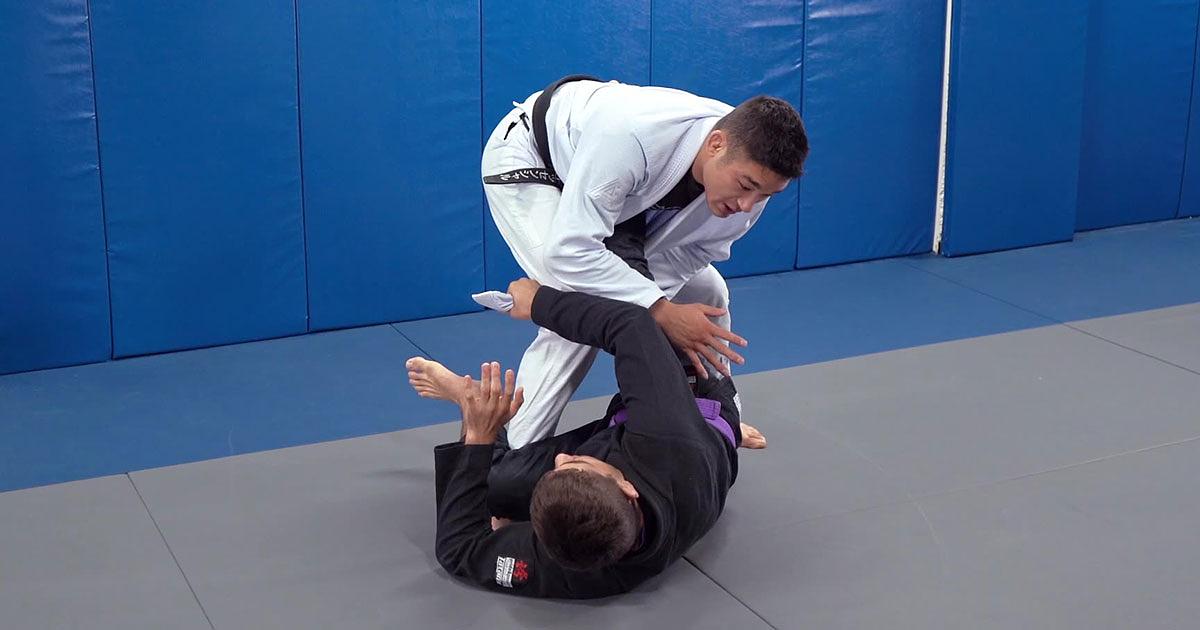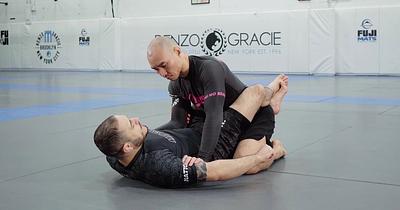Overview of Modern Lapel Guards Including Worm Guard
by Team Digitsu
Updated: April 16, 2024

Brazilian Jiu-Jitsu (BJJ) is a martial art and combat sport based on grappling and ground fighting, with the objective being to control and submit your opponent. It's practiced wearing a gi, which not only serves as a uniform but also as a tool for many techniques. One inventive use of the gi in BJJ is the worm guard, a novel position that has gained popularity among practitioners looking for an effective way to handle aggressive passers.
Originated by Keenan Cornelius, the worm guard is a sophisticated open guard variation where you use your opponent's lapel to create control and leverage. By wrapping the lapel around your leg and then under their leg, you can break their posture and set up various sweeps and submissions. This utilization of the gi is both a testament to the dynamic nature of jiu-jitsu and an illustration of how BJJ continues to evolve.
When applying the worm guard, your ability to manage the distance between you and your opponent is greatly enhanced. The technique requires precise grip and foot placement; however, once established, it can be a formidable weapon in your BJJ arsenal. Not only does it allow for creative transitions into dominant positions, but it also opens a wide array of possibilities to off-balance and submit an opponent who might otherwise be difficult to control.
Origins of the Worm Guard
The worm guard has emerged as a modern evolution of lapel guards, becoming a distinct and complex position that redefined competitive grappling strategies at elite levels.
Keenan Cornelius' Influence
Keenan Cornelius, hailing from San Diego, California, is the innovative grappler credited with developing the worm guard. His adaptation shook the BJJ community during the 2014 Pan American Championships. Cornelius' new application of the lapel in guard ensured a unique control over opponents, becoming a staple for many practitioners. His contribution has since been absorbed into the broader curricula as an advanced guard strategy.
Fundamentals of Worm Guard
Mastering the Worm Guard can significantly enhance your guard game by offering a unique way to control an opponent using the gi lapel. This control is central to employing tension and creating opportunities for offense or defense.
Understanding the Lapel Guard
The Worm Guard is a subset of the lapel guard, a position where you utilize your opponent's gi lapel to enforce control. To initiate this guard, you wrap the lapel around your leg, usually from a guard position, effectively engaging multiple points of contact with your opponent.
Steps to Enter the Worm Guard:
- Obtain control of the opponent's lapel.
- Sit-up to create space and maneuverability.
- Wrap the lapel around your leg, passing it over the opponent's leg closest to you.
By doing so, you increase your leverage and the ability to manipulate your opponent's movements and posture.
Core Concepts and Tension
The efficacy of the Worm Guard lies in the principle of tension. Maintaining constant tension in the lapel between you and your opponent is critical; it serves as the anchor of your control and the foundation for subsequent attacks or sweeps.
Considerations for Maintaining Tension:
- Always pull the lapel tightly, preventing any slack.
- Your grips must be strong and precise.
- Position your body in a way that the tension in the lapel aids in disrupting your opponent's balance and posture.
Understanding and applying these concepts will enable you to use the Worm Guard effectively, whether you're setting up sweeps, submissions, or simply stalling your opponent's attacks in gi matches.
Key Techniques and Positions
Mastering the worm guard requires a deep understanding of key techniques and positions. This guard variation, which emphasizes the use of your opponent's gi, offers several strategic advantages including sweeps, submissions, and transitions. Here's how you can apply this innovative guard.
Sweeps
When you entangle an opponent using the worm guard, sweeps become highly effective. A fundamental sweep involves controlling their lapel, positioning your shin against their thigh, and upsetting their balance to execute the reversal. Notably, you can advance from the open guard to a more dominant position, such as mount or even achieve a back take.
- Scissor Sweep: Trap your foot with the lapel, switch grips and chop their leg while sitting up to sweep.
- Lapel Sweep: Pass the lapel under your leg, off-balance your opponent, and transition to the top.
Submissions
The worm guard also opens opportunities for submissions. The control it gives you over your opponent’s posture allows for setups to various chokes.
- Lapel Chokes: With the lapel grip, you can threaten chokes from the guard.
- Armbar: Using the lapel to control the arm, pivot your hips for the armbar submission.
Transitions from Worm Guard
Transitions from the worm guard to other positions are pivotal for maintaining the upper hand in a match. The worm guard can fluidly transition to various forms of closed guard or enable you to move into more advantageous positions.
- Closed Guard: Use the lapel to pull yourself into a closed guard, setting up for further attacks or sweeps.
- Open Guard Variants: Transition through different types of open guard to keep your opponent guessing and off-balance.
Integrating Worm Guard into Your Game
Mastering the Worm Guard in is a game-changer, particularly when you're seeking to enhance your guard play in the gi. It's a specialized form of lapel guard that can offer you unique control over your opponent.
Entries
To solidly incorporate Worm Guard into your repertoire, you must have reliable entries. You can initiate a Worm Guard from various positions, but common entries often involve a connection to lapel guards. For instance, from the De La Riva guard, you can grab your opponent's lapel and transition seamlessly into the Worm Guard.
Counters
Being versed in counters against common defenses is critical. When your opponent attempts to pass or dismantle your Worm Guard, knowing how to counter their moves keeps you a step ahead. It involves a mix of grips adjustments and hip movements to nullify their passes, which often means transitioning into a half guard to maintain control.
Combining with Other Guards
To truly excel, you should be fluid in combining Worm Guard with other guard systems. Integrate transitions into the spider guard or the De La Riva guard for a dynamic guard game. For example, if an opponent manages to begin a pass, you might transition to a spider guard to recalibrate your attack.
By focusing on these three core areas, you'll develop a comprehensive understanding that allows the Worm Guard to become a foundational element of your Jiu-Jitsu game.
Drills and Exercises for Worm Guard
To enhance your Worm Guard game in Brazilian Jiu Jitsu, it's essential to integrate specific drills that build muscle memory and refine your technical execution. Here are exercises tailored to developing a strong Worm Guard.
Lapel Control Drills Start with drills focused on controlling and managing the lapel, which is pivotal in establishing the Worm Guard. Practice passing the lapel around your leg and transferring it from hand to hand to gain fluidity.
- Pass the lapel around your leg — Repeat 10 times each side.
- Swap lapel control between hands — 2 sets of 15 repetitions.
Worm Guard Entries Your entry into the guard sets the foundation for your offense or defense. Rehearse getting into the Worm Guard from various guard positions.
- Closed Guard to Worm Guard transition — 5 repetitions each side.
- Half Guard to Worm Guard — 5 repetitions each side.
Sweeps from Worm Guard A well-executed sweep from the Worm Guard can shift you from a defensive position to a dominant one. Practice these sweeps to become more versatile.
- Basic Lapel Sweep — Practice chop and lift motion, 5 repetitions each side.
- Reverse De La Worm Sweep — Focus on hip movement, 5 repetitions each side.
Remember, repetition is key. Aim to practice these drills regularly to see noticeable improvements in your Worm Guard application during sparring sessions.
Worm Guard in Competition
The worm guard has become an integral part of competition, particularly in matches where the gi is used. Its effectiveness is showcased in high-profile tournaments, turning it into a game-changer for skilled competitors.
Notable Matches and Competitions
- Keenan Cornelius at Copa Podio: Keenan Cornelius, the innovator of the worm guard, demonstrated the potential of his creation in various matches at the Copa Podio, solidifying the technique's place in modern BJJ competition.
- IBJJF World Championships: This guard has been featured in numerous fights at the highest level of BJJ competition, where competitors utilize the worm guard's control over the lapel to gain advantage and secure victories.
Remember, when you're watching these matches, observe how competitors use the worm guard to control the pace and flow of the fight—not just as an aggressive tool, but also defensively to frustrate and neutralize the attacks of their opponents.
Advanced Concepts and Variations
Worm guard becomes a pivotal facet of your lapel guard game—a sophisticated tool designed to shift control in your favor. This section examines intricate aspects of worm guard, offering guidance on its advanced variations known for their efficiency and complexity.
Reverse de la Worm
The Reverse de la Worm presents a clever twist on the traditional worm guard, by incorporating additional layers of control. Here, your typical worm guard setup evolves as you secure an underhook on the far leg and then invert, wrapping the lapel around your opponent’s thigh. This generates significant tension and hinders their movement, placing you in an advantageous position to execute sweeps or transitions.
Lapel and Sit-Up Guard Synergy
Lapel guards are renowned for their robustness, and when seamlessly integrated with the sit-up guard, they form a composite guard known as the Lapel and Sit-Up Guard Synergy. This alliance emerges as you manage to sit-up while maintaining your lapel grip, using the gi to create leverage. This posture can effectively neutralize adversaries and pave the way for diverse attacking strategies, employing your upper body strength and controlled tension within the gi to maximum effect.


